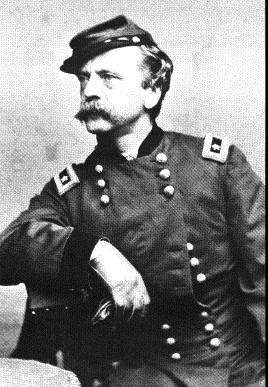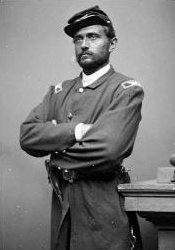Pap Greene, David Ireland, and Little Round Top

Every Gettysburg fan with even just a passing knowledge of the battle knows the story of Col. Joshua Lawrence Chamberlain and the 20th Maine on Little Round Top. Those with a deeper understanding of the battle know that an equally desperate fight took place on the other flank of the Union army, on Culp’s Hill. I’ve always felt a little bad for Col. David Ireland for not getting the same accolades that Chamberlain has gotten for an equally heroic struggle.
Yet it very well might have been Ireland on Little Round Top in the story we would know so well today, and he, not Chamberlain, would be the one-man cottage industry. Ireland and his brigade had been posted on the southern end of the battlefield late on July 1.
First, let me say that I am in no way detracting from Chamberlain’s efforts. I think he and his regiment deserve the accolades they have earned over time. Like some folks, I do get tired of the over-hype, but that’s not necessarily Chamberlain’s fault, so I don’t hold it against him personally.
As a professor of rhetoric, it’s little wonder that Chamberlain wrote about his experiences in the war. And, like any old soldier, he liked to revisit his glory days. Because he had extraordinary talents with a pen that most veterans did not, his revisitations to Little Round Top gained a lot of traction in the years since.
That’s what brought him to the attention of Michael Shaara, chose Chamberlain as one of his central characters in The Killer Angels. The novel was not a huge commercial success despite winning the 1975 Pulitzer Prize for Fiction. The novel only took off after Ken Burns, inspired by Chamberlain’s story, featured him prominently in his Civil War film. The release of the movie Gettysburg in 1993, adapted from Shaara’s novel, added to Chamberlain’s luster. He’s been a national hero ever since.
I’m contrast, no one wrote a famous novel or made a famous movie that featured events on Culp’s Hill. Without that pop-culture spotlight, the events there have been relegated to the optional third hour of a Gettysburg driving tour—sort of like, “Hey, see it if you can.”
And so the story of Pap Greene’s brigade, and David Ireland’s 137th New York on the extreme right flank, have remained in the shadow of the more famous hill to the south. Adding to Ireland’s obscurity, he died on September 10, 1864, outside of Atlanta after contracting dysentery—a horrible and humiliating way to go. He never lived long enough to recount his story the way old soldiers do. Although once described by his local newspaper “a kind and gentlemanly officer and a brave soldier,” he’d been a clerk prior to the war and didn’t have had the same rhetorical powers Chamberlain did.[1]
Despite these factors, fate put Ireland in Chamberlain’s shoes for a brief span on July 1—or at least close enough.
As Winfield Scott Hancock tried to piece together a defensible position on Cemetery Hill from the scraps of the retreating I and XI Corps, he got much-needed relief from the appearance of Maj. Gen. Henry Slocum’s XII Corps, approaching from the east. Slocum’s first division, under Brig. Gen. Alpheus Williams, took up a position on the Union right. But Hancock was also looking to the south, toward Little Round Top miles away. The hill commanded “the Gettysburg and Emmitsburg road, as well as the Gettysburg and Taneytown road to our rear,” Hancock realized.[2] Other officers agreed those possessing them would be “of the utmost importance, since their possession by the enemy would give him an opportunity of enfilading our entire left wing and center with a fire which could not fail to dislodge us from our position.”[3]
Hancock could not communicate with Slocum directly, so he took personal responsibility for diverting Slocum’s next division, that of Brig. Gen. John Geary, to move to Roundtop. “[T]hat is the key to this position,” Hancock said, “and if we can gain position on it before the enemy, we can form a line and fight a battle, but if the enemy secures it first, we will be compelled to fall back about seven miles [sic] to Pipes’ Creek.”[4]
Geary later wrote that “the right could maintain itself,” and “the immediate need of a division on the left was imperative. By his direction, on this threatening emergency, I took up position on the extreme left of the line of battle.”[5]
By 5 p.m., Geary had placed his first and third brigades, Col. Charles Candy’s and Brig. Gen. George S. “Pap” Greene’s, around Little Round Top. (Candy’s men actually held the left-most position.) And there Pap Greene’s brigade spent the night. “There were no incidents of note,” Greene wrote in his official report.[6]
Had fighting erupted there, or had the two brigades stayed in place, there’s no doubt the history of Little Round Top as we know it today would be written much differently. Who knows whose names we’d now remember.

As it was, around 5 a.m. on July 2, the arrival of Dan Sickles’s III Corps from Emmitsburg relieved Geary’s men, and they pulled out to reunite with the rest of the XII Corps. Hancock’s own II Corps had also arrived and began filling in along Cemetery Ridge. Army commander George Gordon Meade, by then on the field, directed the III Corps to “occupy the continuation of the Cemetery Ridge,” anchoring its position on Little Round Top.
As Gettysburg fans know, Sickles disobeyed orders and did not place his troops as ordered. Meade, concerned about Little Round Top all day and expecting a Confederate attack at any minute, finally sent his chief topographical engineer, Brig. Gen. Gouverneyr K. Warren to check out the position. That led to the stream of events that put Strong Vincent’s V Corps brigade the top of the hill, with the 20th Maine on its left flank. And the hero is born!

This also raises a fun question—one that is largely beyond the scope of my ruminations today—and that is: had Sickles occupied the position as ordered, his left flank would have been held by Brig. Gen. Hobart Ward’s brigade, with the 124th New York as its left-most regiment (based on the way he deployed his line along the Emmitsburg Pike, Peach Orchard, and Wheatfield). Perhaps Col. Augustus van Horne Ellis would have had the opportunity to eventually become the Chamberland-like cottage industry. (Ellis would be killed during the battle, though.)
Maybe Ellis’s fate suggests that, on a personal level, maybe it was better for Pap Greene that he didn’t stay at Little Round Top. His eventual counterpart there, Col. Strong Vincent, would be killed, as for the fellow brigade commander Brig. Gen. Stephen H. Weed.
The best we can do to remember the heroics of Ireland, Greene, and their compatriots is to visit Culp’s Hill today. Recent landscape restoration sponsored by the Gettysburg Foundation has opened that portion of the battlefield in dramatic and interpretively useful ways. Go see for yourself. It’s an underappreciated, undertold story of the battlefield that deserves every bit of the attention that has been given to Little Round Top.
————
[1] “Captain David Ireland,” Broome Daily Republican, 27 August 1862.
[2] Hancock report, O.R. XXVII, Pt. 1, 368.
[3] Geary report, O.R. XXVII, Pt. 1, 825
[4] Moses Veale, 109th Regiment Penna. Veteran Volunteers. An address delivered at the unveiling of their monument on Culp’s Hill, Gettysburg, Pa., September 11, 1889, 1890.
[5] Ibid.
[6] Greene report, O.R., XXVVI, Pt. 1, 855.
Thanks Chris. There are quite a few contrasts between the 20th Maine and the 137th NY
1. Both were the “book-end” regiments of the Union line, according to Ed Bearrs.
2. Both regiments refused their flank
3. Both regiments charged bayonets.
4 Both regiments had the same % losses, according to Busey and Martin…32.4%
Culp’s was a great defensive position, but only if you made intelligent use of the topography. Greene and his regimental commanders did. And the there was Old Dyspepsia and Missionary Ridge…
And sorry, Chris, meant to say ANOTHER GREAT POST!
Thanks, John!
John…I agree!
Greene was an experienced military engineer, with an eye for topography. He saw that the saddle was the weak point in the Union line. I’ve walked that ground from East Confederate Ave. to the saddle…it is basically flat.
The traverse is placed just to the North of that weak point. And though I feel it was about 2 companies length, it was directed to the slight cliff where the 29th PA monument is today. That cliff, though small, woujd cause the enemy to momentarily stop.
Great article. With respect to Ireland and Chamberlain, history is not only written by the winners, it is written by the survivors.
Thank you!
Wonderful story. I knew about the roles of Greene and Ireland on Culp’s Hill, but I had forgotten their temporary duty at LRT on July1. I also agree that the 2021 renovation of Culp’s Hill was well done.
I can’t commend the Gettysburg Foundation enough for the work they funded to restore Culp’s Hill. It’s amazing up there now.
thanks for the great essay and nice tribute to General Greene (the oldest General Officer at Gettysburg i believe) and Colonel Ireland.
A few years ago i stumbled across Professor Gary Gallagher’s series on leadership at Gettysburg for the University of Viriginia’s MBA program … Greene and Ireland came up as historical foils to the Killer Angels and the film Gettysburg “mythology” of Chamberlin saving the day on July 2nd … the Professor’s point, of course, was to highlight what happened on the other flank and the powerful differences between history and popular memory …
PS — For those not familar with the fantantic Professor Gallagher (now retired i believe), his Gettyburg series to the UVA business majors is among his best youtube videos
Greene was the oldest Union general, as I recall, he was 62; the oldest on the field was actually his opponent on Culp’s Hill, Brig. Gen. William Smith (the former Governor of Virginia, who was in fact the governor-elect again at Gettysburg), at 65.
thanks Joshua … i have never heard of General Smith … i learn something neat everyday!
Chris, I enjoyed the piece immensely. However, I respectfully suggest that a copy editor review it and make the necessary fixes.
The 137th was from Binghamton New York. They were some of the bravest and toughest solders of the Union army!
What is more amazing is that Colonel Ireland would have taken the hill overlooking Chatanooga had he not been restrained by his drunken commanders. As it was, the Confederates managed to remove every field piece and men from Lookout Mountain overnight, saving them for the battles in Georgia.
The next morning the Union troops entered the summit to find everyone had been removed down the cliff to the river below, making their escape without a shot.
Same thing happened in Gettysburg where fighting was called off around 3pm for te day. Had the Confederats pushed to dusk, Gettysburg would have been lost that first day.